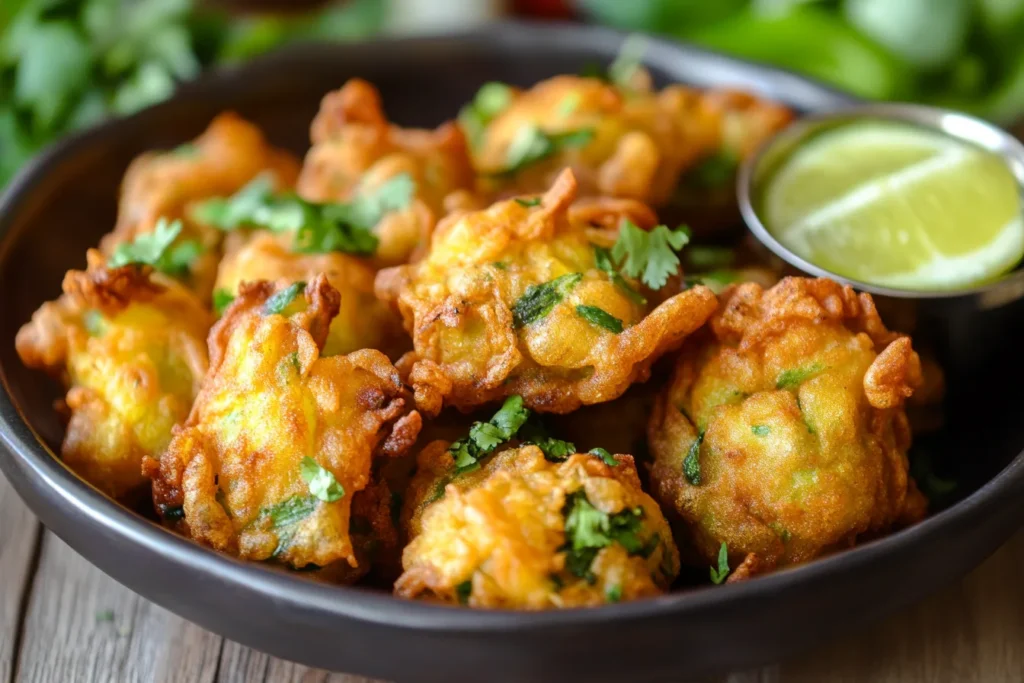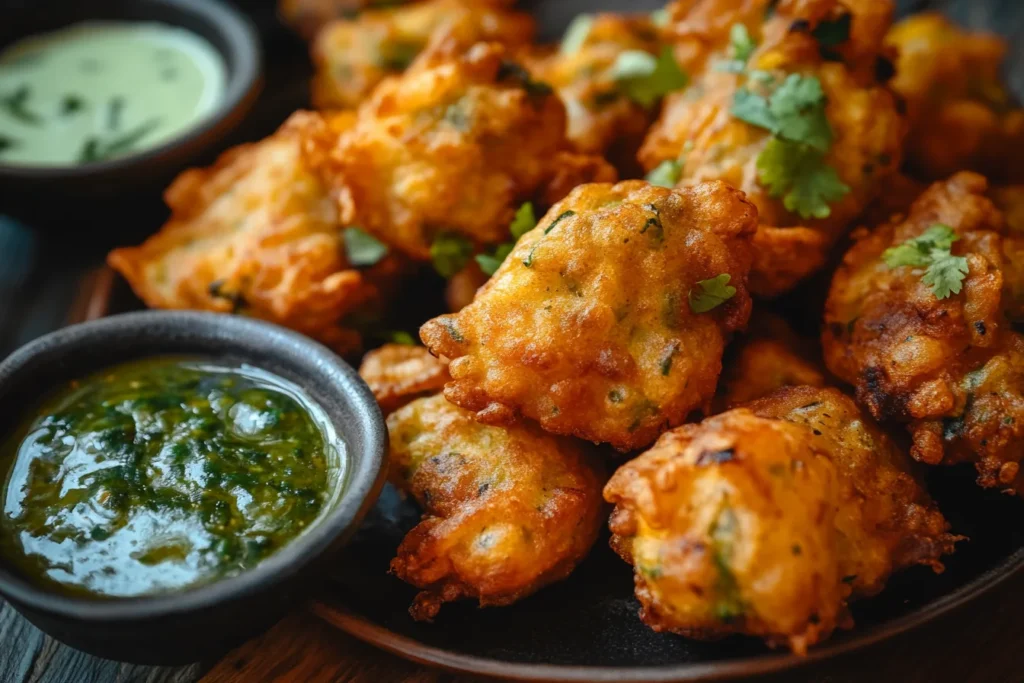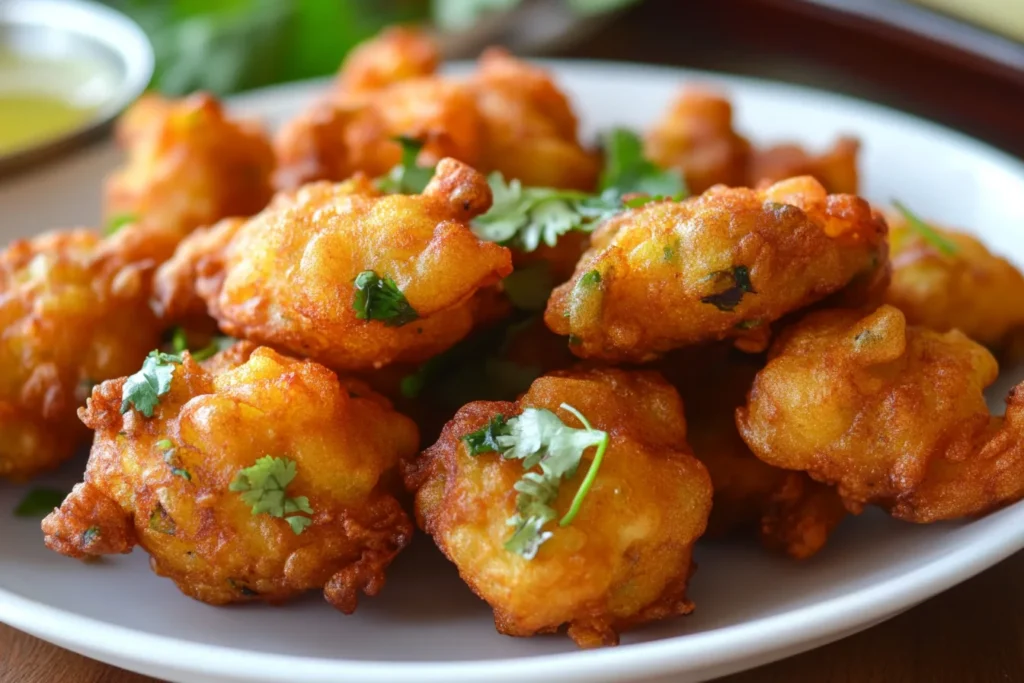Introduction to Bhajiya and Pakora
Bhajiya and Pakora are quintessential Indian snacks, celebrated for their crispy texture and tantalizing flavors. These deep-fried delights are often the highlight of rainy days, festive occasions, or casual tea-time gatherings. While both share similarities in preparation, they are distinct in ingredients, textures, and cultural nuances.
At their core, both snacks involve batter-coated vegetables, spices, and frying. However, their versatility has allowed countless regional adaptations, making them staples in Indian cuisine. This article explores the origins, preparation techniques, and the subtle differences that make each snack unique.

Origin and Cultural Significance
The origins of Bhajiya and Pakora are deeply rooted in Indian history, seamlessly intertwining with the country’s rich culinary traditions. Over time, these snacks are believed to have evolved, influenced by the diverse regional flavors that characterize Indian cuisine. In fact, the art of frying vegetables in seasoned batter has been practiced for centuries, with historical references in ancient texts describing offerings of fried delicacies as part of traditional feasts. This evolution, shaped by cultural and regional adaptations, highlights the enduring appeal of these iconic snacks across generations.
- Pakora is prominently linked to North India, where it is enjoyed with piping hot masala chai.
- Bhajiya, on the other hand, holds a special place in western and southern Indian states like Maharashtra and Gujarat.
These snacks often symbolize hospitality and festivity, making appearances during monsoons, weddings, and religious ceremonies. Their simplicity and adaptability have also earned them a global following.
Common Misconceptions
Many people mistakenly believe that Bhajiya and Pakora are interchangeable. While they do share similarities, there are notable distinctions:
- Shape and Size: Bhajiya tends to be smaller and more uniform, while Pakoras are often chunkier with irregular shapes.
- Batter Composition: Pakora batter typically includes chickpea flour (besan) with spices, while Bhajiya batter may also incorporate rice flour or other regional flours for added crispiness.
These subtle differences influence their taste and texture, debunking the myth that they are identical.
The Role of Bhajiya and Pakora in Indian Cuisine
Bhajiya and Pakora occupy an irreplaceable spot in Indian cuisine, symbolizing both culinary comfort and cherished traditions. From family gatherings to bustling street food stalls, these snacks have become an essential part of Indian culinary culture. For instance, during the monsoon season, Bhajiya served with spicy chutney and a hot cup of tea creates an iconic and deeply satisfying experience.
Similarly, Pakoras, often enjoyed with tangy green chutney or ketchup, bring joy to a wide range of occasions, from festive celebrations to roadside indulgence. Over the years, both snacks have evolved into cultural staples, offering a sense of togetherness and nostalgia. Whether at home or on the streets, they continue to unite communities with their timeless appeal and irresistible flavors.volved into cultural staples, uniting communities over their irresistible flavors.
Regional Names and Variations
India’s incredible culinary diversity is beautifully showcased in the many regional names and versions of these beloved snacks. For example, in Gujarat, Bhajiya is commonly referred to as “Bhajia.” It is often enjoyed as a snack alongside thepla or as a hearty accompaniment to dal, highlighting its integration into local meals. Meanwhile, in Bengal, Pakora takes on a unique identity as “Tele Bhaja,” featuring seasonal vegetables like eggplant or pumpkin, which reflect the region’s preference for fried delights.
In contrast, South India offers a variation akin to Bhajiya, known as “Bonda.” This version is typically prepared with a spiced potato filling and served with coconut chutney, adding a regional flair to the classic snack.
Together, these adaptations not only demonstrate India’s culinary creativity but also reflect the diverse taste preferences and traditions that make each region’s cuisine distinctive.
Base Ingredients Comparison
The key to distinguishing Bhajiya and Pakora lies in their base ingredients:
- Bhajiya: Primarily features sliced onions, chilies, or spinach, combined with gram flour and rice flour for an extra crunch.
- Pakora: Incorporates a variety of vegetables such as potatoes, paneer, or cauliflower. The batter is thicker, emphasizing a spiced coating.
The differences in ingredients and batter composition create unique flavor profiles for each snack.
Texture and Taste Distinctions
The texture and taste of Bhajiya and Pakora are worlds apart:
- Bhajiya: Light, airy, and crisp, with a subtle flavor that highlights the vegetables.
- Pakora: Denser, with a spicier and more robust flavor due to the thicker batter and spice mix.
These distinctions cater to diverse palates and occasions, from quick snacks to festive appetizers.
The Art of Preparation
The preparation of Bhajiya and Pakora is an art that balances tradition with technique. Despite their similarities, each snack has unique methods that define its character.
Spices and Batter Consistency
Achieving the perfect Bhajiya or Pakora requires attention to detail:
- Bhajiya: The batter is slightly thinner, ensuring a light coating for crispy results.
- Pakora: A thicker batter clings tightly to vegetables, delivering a bold and spicy bite.
The choice of spices, such as turmeric, coriander, and carom seeds, further distinguishes the flavors of these snacks.
Traditional Pairings and Dips

Here’s a revised version of your paragraph with improved transition words and smoother flow:
No Bhajiya or Pakora experience is truly complete without the perfect accompaniments to enhance their flavors. For instance, a variety of chutneys can be paired to suit different tastes. A refreshing green chutney, made with mint and coriander, brings a zesty freshness, while a tangy tamarind chutney adds a sweet and sour balance to the savory snacks. In addition, beverages like masala chai are a quintessential pairing, as the warm and spiced tea beautifully complements the crispness and spice of both snacks.
Together, these accompaniments elevate the eating experience, transforming simple snacks into cherished treats enjoyed across households and street corners alike.
Key Differences Between Bhajiya and Pakora
Regional Variations and Preferences
The rich regional diversity of India has a profound influence on the preparation and consumption of Bhajiya and Pakora. Each region brings its own unique flair to these snacks, shaped by local ingredients and deeply rooted cultural practices.
In North India, particularly in Punjab and Uttar Pradesh, Pakoras are generously spiced to suit the bold flavors of the region. They are often served as a side dish in a traditional thali or paired with creamy yogurt-based chutneys, making them a household favorite. Meanwhile, in Western India, states like Maharashtra and Gujarat favor Bhajiya. Popular variations include Kanda Bhajiya (onion fritters) and Batata Bhajiya (potato fritters), which are commonly enjoyed as tea-time snacks during the monsoons.
Moving further south, the influence of local tastes becomes evident in dishes like Mysore Bonda and Mirchi Bajji. These variants reflect the Bhajiya style but are often served with aromatic coconut chutney, showcasing the distinct culinary traditions of the region.
Together, these variations not only cater to diverse palates but also celebrate the culinary heritage of each region, preserving the unique flavors and customs that define Indian cuisine.
Key Ingredients in Bhajiya vs. Pakora
While both snacks share a base of flour and spices, the choice of ingredients sets them apart:
- Bhajiya:
- Thinly sliced vegetables like onions, chilies, or spinach.
- A mix of gram flour and rice flour for a lighter texture.
- Subtle spice blends to let the vegetable’s natural flavors shine.
- Pakora:
- Bulkier ingredients like paneer, cauliflower, or potatoes.
- A thicker gram flour batter that enhances the bold spices.
- Sometimes includes yogurt or water to make the batter denser.
This difference in ingredients plays a significant role in their final taste and appeal.
Cooking Methods Compared
Both snacks rely on deep-frying, but their methods vary slightly to achieve different textures:
- Bhajiya:
- Cooked at a medium flame to ensure an even crispiness.
- Smaller portions allow faster cooking and lighter results.
- Pakora:
- Fried at a slightly higher temperature for a denser, crunchier exterior.
- Larger pieces require careful frying to cook evenly without burning.
Mastering these methods is key to creating the perfect snack experience.
Serving Occasions
Bhajiya and Pakora shine in various settings, often tailored to the occasion:
- Bhajiya:
- Monsoon evenings, served with hot chai.
- Weddings and festive events, where they are part of a larger spread.
- Pakora:
- Street food stalls during fairs and festivals.
- Starter dishes at parties, accompanied by chutneys.
Their versatility ensures that they are enjoyed year-round, regardless of the event.
Textural and Flavor Profiles
When it comes to texture and flavor, Bhajiya and Pakora cater to distinct preferences:
- Bhajiya:
- Delicate crispiness with an emphasis on the vegetable’s taste.
- Mild spices for a balanced flavor.
- Pakora:
- Robust crunch, with spices creating a bold flavor profile.
- More batter-heavy, leading to a denser bite.
These differences provide unique sensory experiences, appealing to a wide audience.
Popular Variations of Bhajiya
The The adaptability of Bhajiya has led to numerous regional and seasonal variations, each offering a unique twist. For example, Kanda Bhajiya, known for its crispy onion fritters, often features a subtle hint of green chili, adding a spicy kick. Similarly, Batata Bhajiya, made with thinly sliced potatoes, is fried to golden perfection, creating a classic favorite during monsoon evenings. For those who enjoy bold flavors, Mirchi Bhajiya provides a fiery option, with spicy green chilies dipped in a seasoned batter and fried until crispy. Meanwhile, Palak Bhajiya caters to health-conscious snackers, as spinach leaves coated in batter deliver a crunchy yet wholesome treat.
Each of these variants not only highlights a specific ingredient but also showcases the versatility of Bhajiya, making it a cherished snack across different regions and seasons. Furthermore, the ease of customization ensures that Bhajiya continues to evolve while retaining its traditional charm.
Popular Variations of Pakora
Likewise, Pakora has its own creative adaptations:
- Paneer Pakora: Cubes of paneer dipped in spiced batter.
- Palak Pakora: Spinach leaves coated in a thick batter.
- Cauliflower Pakora: Crispy florets seasoned with bold spices.
- Chicken Pakora: A non-vegetarian twist, featuring marinated chicken pieces.
These variations cater to diverse dietary preferences and taste profiles.
Nutritional Differences
The nutritional aspects of Bhajiya and Pakora differ based on their ingredients and preparation:
- Bhajiya:
- Lower calorie count due to thinner batter.
- Rich in fiber from vegetables like spinach and onions.
- Pakora:
- Higher calorie content due to thicker batter and oil absorption.
- Often protein-rich when made with paneer or lentils.
While both are indulgent treats, moderation is key to enjoying them as part of a balanced diet.
Bhajiya and Pakora Across Borders
These snacks have transcended Indian borders, becoming popular in global cuisines:
- United Kingdom: Often featured as “onion bhajis” in Indian restaurants.
- Middle East: Variants like “falafel-style pakoras” are enjoyed during Ramadan.
- United States: Fusion dishes like “pakora sliders” are gaining traction.
Their global appeal underscores their versatility and universal flavor.
Influence on Modern Cuisine
In contemporary kitchens, Bhajiya and Pakora have inspired innovative dishes:
- Pakora Tacos: A fusion of Indian and Mexican cuisines.
- Bhajiya Wraps: Incorporating crispy fritters into wraps with chutneys.
- Gluten-Free Variants: Using alternative flours like almond or buckwheat.
These innovations show how traditional snacks can adapt to modern culinary trends.
How to Make Bhajiya and Pakora at Home

The Perfect Bhajiya Recipe
Ingredients:
- 2 medium-sized onions (thinly sliced)
- 1 cup gram flour (besan)
- 2 tablespoons rice flour
- 1 teaspoon red chili powder
- 1 teaspoon turmeric powder
- 1 teaspoon carom seeds (ajwain)
- Salt to taste
- Water (as needed)
- Oil (for deep frying)
Step-by-Step Instructions:
- Prepare the Onions: Begin by slicing the onions thinly and separating the layers for even frying. Next, sprinkle a pinch of salt over the slices and let them rest for about 5 minutes. This step helps the onions release moisture, enhancing the batter’s coating.
- Mix the Batter: In a mixing bowl, combine gram flour, rice flour, red chili powder, turmeric powder, carom seeds, and salt. Gradually add water while stirring to create a medium-thick, lump-free batter. The right consistency ensures the bhajiya turn out crispy yet light.
- Combine Onions and Batter: Add the salted onions into the prepared batter. Mix thoroughly, ensuring every slice is evenly coated for a uniform fry.
- Heat the Oil: Heat oil in a deep pan over medium flame. To check if the oil is ready, drop a small amount of batter into the oil—if it sizzles and floats, the oil is at the perfect temperature.
- Fry the Bhajiya: Carefully drop small portions of the coated onions into the hot oil. Be sure not to overcrowd the pan to allow even cooking. Fry the bhajiya until they turn golden brown and crispy, flipping them occasionally for uniform texture.
- Drain and Serve: Once fried, remove the bhajiya using a slotted spoon and transfer them to a plate lined with paper towels to drain excess oil. Finally, serve them hot with your favorite accompaniments like mint chutney or ketchup.
The Perfect Pakora Recipe
Ingredients:
- 1 cup chickpea flour (besan)
- 1/4 cup water (or as needed)
- 1 teaspoon garam masala
- 1 teaspoon cumin seeds
- 1/2 teaspoon baking soda
- Salt to taste
- Vegetables of choice (potatoes, spinach, paneer, cauliflower)
- Oil for deep frying
Step-by-Step Instructions:
- Prepare the Vegetables: Wash and slice your chosen vegetables (e.g., thinly slice potatoes, chop spinach, or cut paneer into cubes).
- Mix the Batter: In a large bowl, combine chickpea flour, garam masala, cumin seeds, baking soda, and salt. Gradually add water to form a thick batter.
- Coat the Vegetables: Dip each vegetable piece into the batter, ensuring it is fully coated.
- Heat the Oil: Heat oil in a deep pan. Test the temperature by dropping a small batter portion—it should float and bubble immediately.
- Fry the Pakoras: Carefully place the batter-coated vegetables into the hot oil. Fry in small batches until golden and crispy.
- Drain and Serve: Use a slotted spoon to remove the pakoras and drain on paper towels. Serve with tamarind chutney or spiced yogurt.
Choosing the Right Ingredients
The success of Bhajiya and Pakora hinges on fresh and high-quality ingredients:
- Use fresh vegetables for better texture and taste.
- Opt for fine-quality chickpea flour for smoother batter consistency.
- Incorporate fresh spices like turmeric and cumin to enhance flavor.
Adjusting the Batter Consistency
Getting the batter right is crucial for the perfect texture:
- For Bhajiya, the batter should be slightly runny to create a light and crispy coating.
- For Pakora, the batter should be thicker to hold denser vegetables firmly.
Pro Tip: Add water gradually while mixing to avoid lumps and achieve the desired consistency.
Deep-Frying Techniques
Deep-frying is an art that requires attention to detail:
- Maintain a consistent oil temperature to prevent undercooking or burning.
- Use a slotted spoon to remove excess oil and ensure even frying.
- Avoid overcrowding the pan to allow the snacks to cook uniformly.
Serving Suggestions
The right accompaniments can elevate your Bhajiya or Pakora experience:
- Dips:
- Mint and coriander chutney for a fresh, tangy kick.
- Tamarind chutney for a sweet and tangy balance.
- Garlic chutney for a spicy edge.
- Beverages:
- Masala chai for a classic pairing.
- Lassi or buttermilk for a cooling effect.
Serving these snacks with the right sides enhances their flavor profile.
Common Mistakes to Avoid
Avoid these pitfalls for the perfect outcome:
- Overloading the Pan: Leads to uneven cooking and soggy snacks.
- Inconsistent Batter: Lumps in the batter result in uneven coating.
- Low-Temperature Oil: Causes excessive oil absorption, making the snacks greasy.
Being mindful of these tips ensures delicious and crispy results.
Customizing Recipes for Dietary Preferences
Adapt these recipes to suit dietary needs:
- Gluten-Free: Use chickpea or buckwheat flour instead of wheat-based alternatives.
- Vegan: Both recipes are naturally vegan-friendly but ensure dips and chutneys do not contain dairy.
- Low-Calorie: Air fry the snacks or bake them instead of deep-frying for a healthier version.
Regional Twists to Experiment With
Add a regional flair to your recipes:
- Gujarati Twist: Add sesame seeds to the batter for a nutty flavor.
- Rajasthani Style: Incorporate spices like asafoetida and dry mango powder.
- South Indian Influence: Use curry leaves in the batter for aromatic notes.
These tweaks make your snacks unique and flavorful.
Storing and Reheating
Follow these tips for storing and reheating:
- Storage: Place leftovers in an airtight container lined with paper towels to absorb excess moisture.
- Reheating: Reheat in an oven or air fryer for crispness. Avoid microwaving, as it makes them soggy.
Proper storage and reheating techniques ensure your Bhajiya and Pakora remain enjoyable even after hours.
More FAQs
- Can I freeze Bhajiya or Pakora batter?
- Yes, store the batter in an airtight container and freeze for up to a week.
- What oil is best for frying?
- Use oils with high smoke points, such as peanut or sunflower oil.
- How can I make my snacks less oily?
- Drain them thoroughly on paper towels immediately after frying.
- Can I use other flours instead of chickpea flour?
- Yes, try rice flour or cornmeal for unique textures.
- What is the best way to avoid soggy snacks?
- Ensure the oil is hot enough and avoid overcrowding the pan.
- Are these snacks suitable for gluten-free diets?
- Absolutely, as chickpea flour is naturally gluten-free.
- What’s the difference between Pakora and Fritters?
- Pakoras are spiced and use chickpea flour, while fritters often use all-purpose flour.
- Can I add cheese to the batter?
- Yes, grated cheese can add richness, especially to Pakoras.
- Is it possible to air fry these snacks?
- Yes, air frying is a healthier alternative that retains crispiness.
- What vegetables work best for Bhajiya?
- Onions, spinach, and chilies are classics, but you can experiment with zucchini or eggplant.

